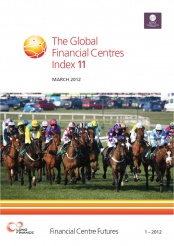Difference between revisions of "ZYen:Global Financial Centres Index"
Marc morris (Talk | contribs) |
Marc morris (Talk | contribs) |
||
| Line 1: | Line 1: | ||
| + | [[File:GFCI11 frontcover.jpg|thumb|174px|[http://www.longfinance.net/Publications/GFCI%2011.pdf Download GFCI 11]]] | ||
== Overview == | == Overview == | ||
| + | |||
After a year of trials, in 2006 the City of London Corporation and Z/Yen Group launched a ranking for financial centres, the [[ZYen:Global Financial Centres Index|Global Financial Centres Index]] (GFCI). The GFCI is an ‘index of indices’, based on a number of existing rankings, in combination with a regular survey of senior industry figures. Published every six months, the GFCI is dynamic, tracking the changing perceptions of cities as financial centres on an ongoing basis. | After a year of trials, in 2006 the City of London Corporation and Z/Yen Group launched a ranking for financial centres, the [[ZYen:Global Financial Centres Index|Global Financial Centres Index]] (GFCI). The GFCI is an ‘index of indices’, based on a number of existing rankings, in combination with a regular survey of senior industry figures. Published every six months, the GFCI is dynamic, tracking the changing perceptions of cities as financial centres on an ongoing basis. | ||
Latest revision as of 10:22, 19 July 2012
Contents |
[edit] Overview
After a year of trials, in 2006 the City of London Corporation and Z/Yen Group launched a ranking for financial centres, the Global Financial Centres Index (GFCI). The GFCI is an ‘index of indices’, based on a number of existing rankings, in combination with a regular survey of senior industry figures. Published every six months, the GFCI is dynamic, tracking the changing perceptions of cities as financial centres on an ongoing basis.
[edit] Method
The GFCI provides ratings for financial centres
calculated by a ‘factor assessment model’ that
uses two distinct sets of input:
1. Instrumental factors (external indices that
contribute to competitiveness): Previous research indicates
that there are many factors that combine to make a
financial centre competitive. These can be grouped
into five overarching areas of competitiveness –
People, Business Environment, Market Access, Infrastructure and General Competitiveness. Objective
evidence of competitiveness was sought from
a wide variety of comparable sources. For
example, evidence about the infrastructure
competitiveness of a financial centre is drawn
from a survey of property and an index of
occupancy costs. Evidence about a fair and
just business environment is drawn from a
corruption perception index and an opacity
index. A total of 64 external sources were used
in GFCI 6. Not all financial centres are
represented in all the external sources, and
the statistical model takes account of these
gaps.
2. Financial centre assessments: By means of an online questionnaire, running continuously since 2007, we now have 36,497 financial centre assessments drawn from 1,802 respondents. Respondents assess the competitiveness of financial centres that they know. The online questionnaire is ongoing to keep the GFCI up-to-date with people’s changing assessments.
[edit] Key areas
The people index summarises the availability of a skilled workforce, the flexibility of the labour market, the quality of the business education and the skillset of the workforce. The business environment aggregates and values the regulation, tax rates, levels of corruption, economic freedom and how difficult in general it is to do business. To measure regulation an online questionnaire has been used. The market access index looks at the various equities and bonds available. The volume and value of trading but also the cluster effect of the number of different financial service companies at the location influence the index. The infrastructure index furthermost accounts to the price of real estate at the location. Other factors such as public transport have a minor impact. General competitiveness relies on more traditional economic factors as price level, quality of life and economic sentiment.
[edit] Industry sectors
The ranking does sub rankings in the main area of financial services as banking, asset management, insurance, professional services, government and regulation.
[edit] Results
The results of the latest GFCI can be found on the Financial Centre Futures homepage of the Long Finance website.
[edit] Centres
Below is a list of all the financial centres ranked in the Global Financial Centres Index.
